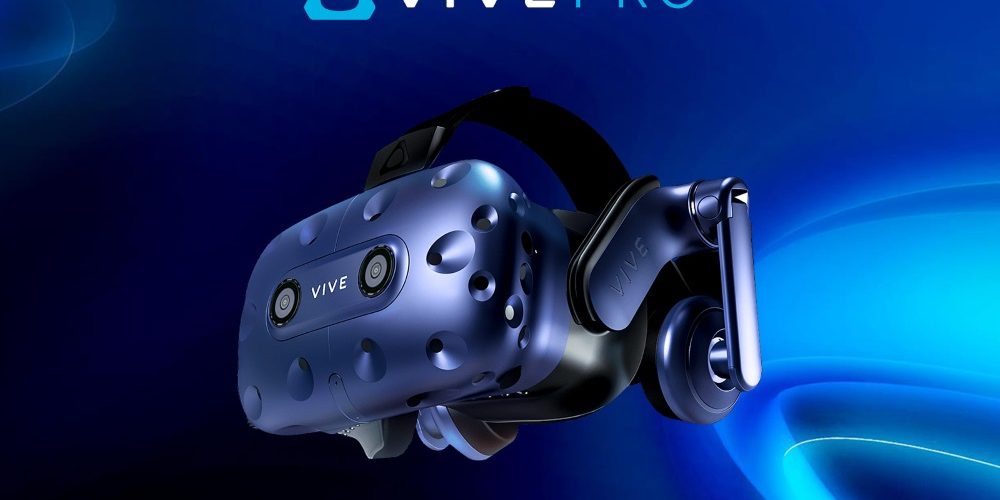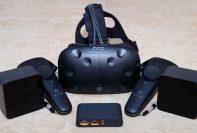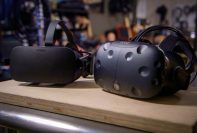HTC has been at the cutting edge of virtual reality hardware since the medium went mainstream.
This tech giant has been relatively successful in the VR industry, and is without a doubt known as one of the top VR hardware companies at this time.
It’s not like HTC’s popular VR headset the HTC Vive was any less powerful than the other high-end VR headsets available, but a company that aims to capture the largest market share can’t afford to miss any chance of gaining a competitive edge.
With rival VR hardware company Oculus generating hype with its Santa Cruz VR headset prototype, HTC had to match its rival’s progress.
HTC did just that; on the April 5th 2018, the HTC Vive Pro was launched.
Oculus and HTC are now at the center of a debate very similar to the one about the Sony PlayStation and Microsoft’s Xbox.
Both companies have captured a major share of the VR market, and somehow each product of either company can be compared to a product manufactured by the other one.
And so there are a lot of people who want to buy a top-tier VR gaming setup, but can’t decide which VR headset is best for them.
In this article, we will discuss everything you need to know about the HTC Vive Pro, to decide if that device is the one for you.
Perhaps the best feature of the Vive Pro is that it is marginally more powerful than the HTC Vive, and doesn’t have an entirely new library of games that go with it.
So, if you have bought a lot of VR games from Steam or Viveport, you can play them on the HTC Vive Pro, too.
Of course, the experience of those games will be a lot better, as the HTC Vive Pro has more pixels per inch in its display, and so renders better graphics than the HTC Vive.
Tethered to a PC with the recommended configuration, the Vive Pro offers the most powerful VR performance available.
However, the improved performance also results in a higher price tag than most VR headsets on the market.
Don’t get the wrong message here; the HTC Vive Pro is, without a doubt, one of the best VR headsets you can get your hands on.
The high price will be justified for you once you fire up a graphics-hungry VR experience on your Vive Pro tethered to a high-end PC.
It will be impossible for your eyes to adjust again to the low-resolution output of the HTC Vive, once you have had a taste of the Vive Pro.
Release Date and Price
The HTC Vive Pro went on sale on the April 5th 2018, and was accompanied by the 1.0 base stations.
On the 23rd of the same month, the Vive Pro started shipping with the advanced 2.0 base stations.
HTC has promised that a complete package of the Vive Pro will hit the market soon.
The price of that bundle is yet to be announced.
The Vive Pro costs $799 on its own without any of the required accessories.
If you have a Vive headset, you can use the motion controllers and base station from that headset with the Vive Pro.
If not, then you will have to buy the accessories; these cost another $230.
Usually, people only consider the price of the headset and its accessories when planning to buy a VR headset.
High-end VR headsets require a powerful PC for both their general processing and their graphical processing needs.
In simpler terms, if you are going to buy an HTC Vive Pro, you will have to consider also purchasing an above-average gaming PC.
If you are a gaming fanatic and have a high-end PC already, you are safe.
However, if you don’t, then you should consider setting aside the $1,500-$2,500 that you will need to spend to get the best computer configuration for your HTC Vive Pro.
The company officially recommends an NVIDIA GeForce GTX 1070, Nvidia Quadro P500, or AMD Radeon Vega 56 graphics card.
These graphics cards typically cost about $500 each.
Considering the price of the VR headset, its accessories, and that of a high-end PC, the cost for the latest and greatest of VR gaming jumps to somewhere between $2- and $3,000.
Design
The hype of better visuals and a greater resolution in the HTC Vive Pro is so high that the design changes in the Vive Pro are often overlooked.
There are a lot of design traits in the new Vive Pro headset that play a major role in making the VR headset better than many other high-end VR headsets on the market.
New Built-In Headphones
The first feature that anyone with serious gaming intentions will notice is the built-in headphones that can be adjusted to sit directly on top of your ears.
The headphones also have intuitive volume controls that allow you to adjust their volume easily, unlike in the HTC Vive headset; the latter requires that you take the headset off to set the volume.
More Comfortable Harness
The uncomfortable and inefficient Velcro straps included in the HTC Vive have been replaced, in the Pro, with a new harness that holds the headset more firmly on your head.
The new harness also decreases the head strain that many people complained about after long gaming sessions with the HTC Vive.
Moreover, the headset won’t budge, even during intense movements, allowing you to retain your focus on the experience instead of worrying about your expensive headset falling off.
The harness also has a turn knob at its back that you can use to tighten the harness’ grip on your head, as well as loosen the grip to take it off without undoing the top strap.
Slim Tethering Cable
The new tethering cable is now more manageable, as it’s slimmer and contains a single wire.
However, I would highly recommend that you opt for the $299 wireless adapter, which will free you from the constraints of using wires to connect your HTC Vive Pro headset to your computer.
Improved Nose Guard
On the inside, you will notice that the nose guard has also been improved; it now sits even more snugly on your nose.
This allows the headset to isolate completely the inside of the headset, keeping outside light from filtering through the cracks between your nose and the nose guard and marring your experience.
Dual-Lens Front-Facing Camera
The HTC Vive Pro features a dual-lens front facing camera setup that will allow developers to create even better and more-immersive augmented reality and mixed reality experiences.
The new front-facing camera setup also results in more accurate tracking of both the objects in the player’s physical environment, and the player’s movement in that environment.
The Downside
Perhaps the only flaw in the design of the HTC Vive Pro headset is that it uses the same accessories that came out with the original HTC Vive.
This also is a cost-saving feature for people who already own an HTC Vive and want to buy the Vive Pro.
However, using the original controllers with the new Vive Pro headset can result in a bit of jitter and inconsistency; these break the immersion of the VR experience.
It’s not that big of an issue, but, although minor, it can get quite annoying after a while.
Performance
We know that the HTC Vive Pro is much better than the HTC Vive and other popular high-end headsets.
We know it’s ridiculously expensive.
The question that remains, is what will the Vive Pro offer that other high-end VR headsets can’t?
What you may get with the HTC Vive Pro depends on how powerful your computer is.
Running the Vive Pro with an underconfigured PC will yield almost no difference, in comparison to the performance of the HTC Vive.
In some cases, your VR experience could get so choppy and full of glitches that you might actually get a headache; the fear of experiencing that again might scare you away from VR gaming altogether.
Connect your HTC Vive to a PC with the recommended configuration or better, and you will experience VR games like you never have before, no matter which high-end VR headset with which you want to compare the Vive Pro.
Better Display
First things first: The ultimate task of the VR headset is to show sparkling visuals on those two display screens, so we will discuss that.
The Vive Pro features a 3.5-inch AMOLED display (divided into two equal panels for each eye) that has a resolution of 2880 x 1600, resulting in a pixel density of 615 pixels per inch.
Compared to the 2160 x 1200 resolution and 448 pixel-per-inch density of the original Vive’s OLED screen, the Vive Pro has clearly won this round.
Of course, the visuals in the HTC Vive are incomparable to those of the HTC Vive Pro.
Higher resolution results in a higher pixel density per inch, which means that more-detailed graphics can be displayed on a screen of the same size.
Images in the Vive Pro are even sharper, and the appearance of rough edges is almost negligible.
Even objects in the distance look sharper in the display of the HTC Vive Pro.
90 Hz Framerate at Higher Resolution
The HTC Vive Pro’s display has a refresh rate of 90 Hz and a 110-degree field of view.
Both of these numbers are the exact same in the original HTC Vive because it can’t be improved any more without the price of the product increasing further.
Most people don’t realize this, but the 90 Hz refresh rate of the HTC Vive Pro is actually a major improvement when compared to the 90 Hz refresh rate of the HTC Vive.
The explanation is simple: The original HTC Vive can update each of its 2160 x 1200 pixels 90 times in a second, while the Vive Pro has to update each of its 2880 x 1600 pixels 90 times in a second.
This means that the Vive Pro is capable of working much faster than the HTC Vive in updating the display.
Seamless Visual Data Processing
What makes the Vive Pro better than other high-end VR headsets is that even with such a high framerate at a high resolution, other subsystems of the VR headset work in perfect sync with the display, and do not decrease the performance of the headset at all.
Taking environmental data, reading the sensors, getting controller inputs, and other such vital tasks are performed seamlessly by the HTC Vive Pro.
Full Room-Scale VR Capability Out of the Box
The Vive Pro is capable of both one-to-one and full room-scale VR tracking.
The full room-scale tracking feature comes out of the box without any need for extra hardware.
Full room-scale tracking has been one of the most significant factors in the HTC Vive Pro’s success.
The VR headset is capable of providing a full room-scale VR experience in playspaces as large as 15 x 15 feet.
Clearer and Sharper Visuals
Ultimately, the graininess in the image that you must have noticed when using the HTC Vive or Oculus Rift is almost nonexistent in the Vive Pro.
You may notice some blurring on the 3D objects, but only when you are specifically focusing on those objects to look for the graininess.
Better visuals combined with a usually-consistent 90 Hz framerate results in an ultra-level gameplay experience.
Sometimes-Choppy Framerate
The performance of the Vive Pro falls short when loading and starting graphics-intensive segments of a game, or when you’re switching from one game to another.
The game becomes only briefly choppy, but this can be enough to kill your mood.
The jitter and choppy gameplay are fine in traditional displays.
In VR, however, you can feel quite uncomfortable, confused, and off-balance if it happens for long enough before the video feed recovers a consistent flow.
Crackling in the Built-In Headphones
Another issue in the Vive Pro about which some people have been complaining is the VR headset’s audio system.
In some of the headsets, the headphones start to crackle at higher audio output.
For instance, the sound of a bomb explosion or of a supercar revving its engine would result in a horrifying crackle, in addition to the intended output.
This may seem like a minor issue, but loud static noise can easily ruin the immersion of a VR experience.
Moreover, if the crackle is being caused by faulty hardware, you might have to buy new headphones.
The HTC Vive Pro VR Gaming Setup
As mentioned before, the HTC Vive requires a very serious gaming computer to work at its best, and provide you with the ultimate possible VR experiences.
As mentioned in the product’s official page on HTC’s website, the HTC Vive requires at least an Nvidia GeForce GTX 1070, an Nvidia Quadro P500, or an AMD Radeon Vega 56 graphics card “or better” to achieve its full potential.
Also, your PC should be powered by at least an Intel Core i5-4590 (4th generation), or AMD FX 8350, or better, processor.
If you haven’t upgraded your PC in a long time, you will probably have to shell out between $1,000 and $1,200 just for the necessary computer upgrades.
If you are on a tight budget, buying an HTC Vive Pro headset without an accompanying system might be a waste of your money.
You can get the Vive Pro started, and even launch VR games on it, with an underconfigured PC; your gameplay experience, however, will be ultimately unsupported.
If possible, wait awhile and save some money for your computer upgrades, or look into other high-end VR headset options that both won’t cost as much and don’t require such a ridiculously powerful computer to work properly.
One thing that you need to know about setting up the HTC Vive Pro for the first time is that there isn’t a one-click installer app available.
You will have to spend a decent amount of time on finding, downloading, and updating countless drivers that are required by the VR headset.
If you have been through the frustrating ordeal of setting up the HTC Vive, you should know what I’m talking about, and setting up the Vive Pro will be fairly easy for you.
If you’re new to VR, however, this process may be difficult for you, and you will probably have to do a lot of research to figure out what went wrong in the setup process.
A lot of VR hardware is designed to make do, even when the drivers are slightly outdated.
The HTC Vive Pro is not one of those VR headsets.
To be able to run the Vive Pro, all the required drivers must be completely up-to-date.
The controllers, the headset itself, and the lighthouses all need the latest firmware released by HTC to run.
Your Steam VR application must also be updated to the most-recent version.
Most importantly, your graphics card must be updated to the latest version released by the manufacturer to avoid crashing due to graphics processing errors.
Even after double-checking every driver and all firmware and software, things can still go wrong; your HTC Vive Pro may not boot up, or may not work properly even if it does.
Suffice it to say, you will need to do a lot of troubleshooting when you’re setting up your HTC Vive for the first time.
If you are not experienced in understanding operating systems, managing drivers and their issues, and researching technical information, it might be impossible for you to set up your VR headset by yourself.
Asking a friend or a local computer store for help might be a better idea than trying to figure out the complexities on your own.
Game Library
One of the most important factors in the success of any VR headset is its content library.
Extremely clear displays and ridiculously high framerates are useless, if there aren’t enough serious VR experiences available for you to enjoy.
VR enthusiasts generally agree that VR gaming will explode in popularity once enough AAA PC and gaming console-matching titles arrive in virtual reality.
The HTC Vive started with a library of small but creative and playful VR experiences that is meant for you to enjoy for a few hours and get an idea of what VR gaming is like.
Over the course of the last two years, however, HTC has really brought in some new content.
The company is encouraging more and more top-tier game developers to produce exclusive and ported games for the HTC Vive platform.
Three of Bethesda’s massive game worlds include The Elder Scrolls V: Skyrim, Fallout 4, and Doom.
Skyrim and Fallout 4 both offer gigantic game worlds that are full of mysteries, conspiracies, magic, the original stone age, the stone age after a nuclear apocalypse, vaults, dungeons, dragons, monsters, enchantments, a barrage of weapons, hundreds of side quests, and a storyline that can be explored in hundreds of thousands of different ways.
Both of these games can be replayed from the start at least 50 times following a unique storyline, with about 100 hours of gameplay each iteration.
Doom is a remaster of a Doom game from the 90s; in this version, the title offers ultrafine graphics that will have you on your toes for hours- in a single session.
All the monsters, advanced weapons, explosions everywhere, and stylish character movements will give you a stellar experience.
All three of these top examples of the PC and console gaming world have been ported successfully by Bethesda to the HTC Vive Pro.
And the games mentioned above aren’t only amazing VR games developed for the Pro.
If you’re looking for a serious rhythm game, you can play Beat Saber, in which you are given a red and a green lightsaber; with this weapon, you will have to slice the oncoming cubes at the perfect moment to accumulate score.
Audio Shield is another VR rhythm game with mesmerizing visuals and addictive gameplay.
If you’re ready to move around a little, you should try Sprint Vector, a futuristic racing game where you’ll be sprinting, skiing, and wingsuit gliding through beautiful spaces before reaching the end of a level.
Arizona Sunshine is another VR experience that will keep the adrenaline pumping as you smash the undead hordes.
You can also try Superhot VR; this experience features a unique gameplay, where time stops when you stop moving.
You can freeze abruptly to avoid having bullets hit you, plan your next set of moves, get into action, execute the moves, and freeze again to plan again your next moves.
There are also a lot of fantasy RPG games available for the HTC Vive.
You can play The Mage’s Tale, Left-Hand Path, and Vanishing Realms to get your dose of fantasy worlds full of magic and wonder.
Of course, The Elder Scrolls V: Skyrim is the highlight of fantasy RPG games for the HTC Vive Pro.
If you love action and adventure games, you will truly enjoy your Vive Pro, once you see the long list of options in the VR headset’s content library.
You can play less-exhausting adventure games like Silicon Valley: Inside the Hacker Hostel; Star Trek: Bridge Crew – a highly recommended VR experience; and Adr1ft, a mesmerizing space VR experience that will take you through the horrifying yet beautiful experiences of being stranded in space with limited oxygen, in the middle of a satellite’s wreckage, with no help.
Then we have hardcore shooter and action games like Raw Data, Elite Dangerous: Horizons, Doom VFR, Serious Sam: The First Encounter, Space Pirate Trainer, and Hover Junkies.
These games will make you break a sweat within the first hour of gaming.
As you shoot your way through intense battles, you will feel an adrenaline rush like never before.
You can always get comfortable and go social to relax after an intense and exhausting gaming session on the Vive Pro through games like The Lab and Rec Room.
The Lab is a collection of small minigames that are fun to play, and take less of a toll on you.
Rec Room is a collection of indoor sports combined with social interactions.
You can engage with other people on the server, and play games like badminton and table tennis with them.
Keep in mind that the games I have mentioned above are just the beginning of the HTC Vive Pro’s rapidly growing content library.
You should also know about HTC’s Viveport subscription service that takes your preferences into account, and recommends five new VR game titles based on your prior choices to add to your collection.
You might want to know where all these games are coming from.
It is true that, a few years ago, there were only a handful of decent VR games, and most of them were exclusive to one platform.
Things have changed in the last two years.
The VR gaming industry has gained a lot of traction recently, as more and more developers are creating awesome cross-platform VR games that will blow your mind.
Who are these developers? They typically are the same people who create the best AAA game titles for PC and gaming consoles.
This proves that the gaming industry has accepted VR as a viable medium for serious gaming, as more and more developers are pushing their limits to create amazing VR experiences.
The games mentioned above are created by popular game developers like Ubisoft and Bethesda, as well as creative and capable startup companies dedicated to developing only VR games.
It probably won’t be long before a system-selling title arrives; from that point on, the high-end VR hardware industry will never be the same again.
It’s no secret that system-selling games are the heart and soul of a platform or a specific gaming hardware’s success.
Nintendo-exclusive games are the reason why over 10 million units of the new Nintendo Switch were sold in just the launch year.
Games like this year’s Spiderman, and God of War 4, are the reason why PlayStation 4 beats its rival gaming console Microsoft Xbox in sales every year.
I’m not suggesting that the game library of the HTC Vive Pro doesn’t feature best-in-class games that can be considered the golden standard of VR gaming.
The VR headset’s content library is full of unparalleled VR games.
However, none of them can be considered the Mario 64, Final Fantasy VII, Metal Gear Solid 3: Snake Eater, or Legend of Zelda: Breath of the Wild of VR gaming.
Such marvelous games are what turned the gaming industry into what it is today.
The VR gaming industry will also need revolutionary games like these to increase its popularity.
Extended VR Gaming Sessions
For someone with technical knowledge about VR headsets, this might not be news, but most newcomers to VR gaming may not expect this to happen: You can’t get right into long hours of gaming with your new HTC Vive Pro, especially if this is your first VR headset.
Beginners in VR can actually feel sick after 10 minutes of playing a VR game that has a lot of motion in it.
It will take you some time to train your brain into tolerating more VR in a single run.
How long? It depends on you; playing consistently for 15 to 20 minutes, 3 to 4 times a day over a period of a few weeks should be enough for an average person to build up tolerance for longer, one-hour gaming sessions in VR.
The HTC Vive Pro is no exception to this constraint.
This usually happens because immersive technologies can be very tricky.
VR can fool your brain into believing that this virtual world is the reality now, but on the other hand, your brain knows that you have put on a VR headset.
This causes your mind to look for signs that will allow it to ensure that the virtual world you are in is not real.
These conflicts are the reason why you will feel confused, out of balance, motion sick, and sometimes even nauseated when you start your VR journey.
Comparisons
Our discussion, to this point, of the HTC Vive Pro should give you a detailed picture of what you should expect from HTC’s flagship VR headset.
However, you should also be aware of where the HTC Vive Pro stands in comparison to other popular VR headsets.
HTC Vive Pro vs. HTC Vive
The HTC Vive Pro is unmatched by the HTC Vive in every respect.
The new headset has a better resolution, pixel density per inch, design, comfort, and graphical output than the HTC Vive.
If you own an HTC Vive and you tried a Pro for a comparison, you will never feel satisfied with your Vive again.
Don’t try an HTC Vive Pro headset unless you are ready to buy one!
Those new to VR gaming will be particularly delighted to see how cool a VR experience can be with a high-end headset.
It is also worth noting that the Vive and Vive Pro both share the same content library.
Thus, any game that runs on the HTC Vive can also run on the HTC Vive Pro.
However, every game that runs on the HTC Vive Pro might not work on the HTC Vive.
This is not because the games that don’t run on the HTC Vive are not compatible with it; it’s just that they require too much processing and graphics power for the Vive to handle without glitching.
The reason why both VR headsets share the same library is that the HTC Vive Pro is not an iteration of the HTC Vive.
Instead, the Vive Pro is essentially a remaster of the HTC Vive.
A much more powerful remaster than the original model, but a remaster nonetheless.
HTC Vive Pro vs. Oculus Rift
Facebook’s Oculus, one of HTC’s strongest rivals in VR, released the Oculus Rift in March of 2016.
The Rift was a very strong rival of the HTC Vive until HTC remade the Vive and launched it in the form of the Vive Pro.
The Vive Pro blows the Oculus Rift out of the water.
Compared to the Oculus Rift’s mere 1080 x 1200 resolution with 455 pixels per inch, the HTC Vive Pro’s 2880 x 1600 resolution with 615 pixels per inch is like comparing a mountain to a molehill.
Both of the VR headsets have a refresh rate of 90 Hz, but, again, there is a huge difference between both of the refresh rates, due to a significant difference of total pixels that have to be updated in each frame.
Oculus has done a much better job in developing a powerful standalone VR headset, namely, the Oculus Quest.
But Oculus has nothing currently with which to rival HTC’s Vive Pro.
Verdict
The obvious win for the HTC Vive Pro is its new display.
The higher resolution than that of almost every VR headset on the market now gives HTC’s flagship a clear edge.
The display output is much sharper, the colors are more manageable, and ultimately, VR games look pretty beautiful on the HTC Vive Pro.
And with a 90 Hz refresh rate, you should be able to play any VR game easily.
Most people are awestruck by the improved resolution of the HTC Vive Pro, and so fail to consider its other design improvements.
New built-in headphones are a great improvement; the audio is quite nice, and noise cancelling in most cases.
The harness is redesigned solely to help the users feel comfortable, and it works.
The new padding combined with the improved nose guard results in very comfortable VR gaming sessions.
Also, thanks to the padding and nose guard, there are almost no cracks left for the light from outside to enter.
A completely light-tight VR headset is alone a significant win.
The HTC Vive Pro also has some shortcomings.
The first and clearest one is its setup procedure.
An average person who isn’t familiar with technology may need to spend hours to understand his system configuration, download the latest drivers from the internet, and troubleshoot any problems.
Other issues with the HTC Vive Pro aren’t that significant.
In a very small number of cases, the built-in audio crackles at high sound levels.
Then there is the problem of choppy framerate; this occurs for a very short time when loading a game or entering an intense-graphics cutscene.
The only question that remains now is that, after all the design improvements and augmented resolution, is the HTC Vive Pro worth the $800?
The probable answer is that it’s not.
However, when you compare it to other VR headsets on the market, and notice every detail to which HTC has paid attention, you might be ready to change your mind.
Yeah, the Vive Pro does not justify its $800 price tag, but can you get the same quality of display and beautiful visuals with any other VR headset on the market? No!
In the end, it depends on you; if you are a gaming fanatic, and that extra level of technological advancement is a necessity for you, you won’t find any other VR headset worth your time.
But if you don’t mind sacrificing somewhat the graphical quality of the game, the HTC Vive or the Oculus Rift will be sufficient for your needs, instead of the HTC Vive Pro.




